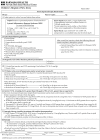The use of an early alert system to improve compliance with sepsis bundles and to assess impact on mortality
- PMID: 22461981
- PMCID: PMC3296210
- DOI: 10.1155/2012/980369
The use of an early alert system to improve compliance with sepsis bundles and to assess impact on mortality
Abstract
Introduction. Diagnostic and therapeutic guidelines, organized as sepsis bundles, have been shown to improve mortality, but timely and consistent implementation of these can be challenging. Our study examined the use of a screening tool and an early alert system to improve bundle compliance and mortality. Methods. A screening tool was used to identify patients with severe sepsis or septic shock and an overhead alert system known as Code SMART (Sepsis Management Alert Response Team) was activated at the physician's discretion. Data was collected for 6 months and compliance with bundle completion and mortality were compared between the Code SMART and non-Code SMART groups. Results. Fifty eight patients were enrolled -34 Code SMART and 24 non-Code SMART. The Code SMART group achieved greater compliance with timely antibiotic administration (P < 0.001), lactate draw (P < 0.001), and steroid use (P = 0.02). Raw survival and survival adjusted for age, leucopenia, and severity of illness scores, were greater in the Code SMART group (P < 0.05, P = 0.03, and P = 0.01). Conclusions. A screening tool and an alert system can improve compliance with sepsis bundle elements and improve survival from severe sepsis and septic shock.
Similar articles
-
An Interdisciplinary Code Sepsis Team to Improve Sepsis-Bundle Compliance: A Quality Improvement Project.J Emerg Nurs. 2020 Jan;46(1):91-98. doi: 10.1016/j.jen.2019.07.001. Epub 2019 Sep 25. J Emerg Nurs. 2020. PMID: 31563282
-
A quality improvement project to improve early sepsis care in the emergency department.BMJ Qual Saf. 2015 Dec;24(12):787-95. doi: 10.1136/bmjqs-2014-003552. Epub 2015 Aug 6. BMJ Qual Saf. 2015. PMID: 26251506 Review.
-
Resuscitation bundle compliance in severe sepsis and septic shock: improves survival, is better late than never.J Intensive Care Med. 2011 Sep-Oct;26(5):304-13. doi: 10.1177/0885066610392499. Epub 2011 Jan 10. J Intensive Care Med. 2011. PMID: 21220270
-
Sepsis Care Pathway 2019.Qatar Med J. 2019 Nov 7;2019(2):4. doi: 10.5339/qmj.2019.qccc.4. eCollection 2019. Qatar Med J. 2019. PMID: 31763206 Free PMC article.
-
Early Recognition and Management of Maternal Sepsis.Nurs Womens Health. 2016 Apr-May;20(2):182-95; quiz 196. doi: 10.1016/j.nwh.2016.02.003. Nurs Womens Health. 2016. PMID: 27067934 Review.
Cited by
-
Brief report: Serial capillary lactate measurement predict the evolution of early sepsis.J Med Life. 2016 Jan-Mar;9(1):74-78. J Med Life. 2016. PMID: 27974919 Free PMC article.
-
Evidence Underpinning the Centers for Medicare & Medicaid Services' Severe Sepsis and Septic Shock Management Bundle (SEP-1): A Systematic Review.Ann Intern Med. 2018 Apr 17;168(8):558-568. doi: 10.7326/M17-2947. Epub 2018 Feb 20. Ann Intern Med. 2018. PMID: 29459977 Free PMC article.
-
A nursing-led sepsis response team guiding resuscitation with point-of-care ultrasound: A review and model for improving bundle compliance while individualizing sepsis care.SAGE Open Med. 2024 Nov 8;12:20503121241290378. doi: 10.1177/20503121241290378. eCollection 2024. SAGE Open Med. 2024. PMID: 39526100 Free PMC article. Review.
-
The design of decisions: Matching clinical decision support recommendations to Nielsen's design heuristics.Int J Med Inform. 2018 Sep;117:19-25. doi: 10.1016/j.ijmedinf.2018.05.008. Epub 2018 May 21. Int J Med Inform. 2018. PMID: 30032961 Free PMC article. Review.
-
Identification of Risk of Early Decompensation and Predictors of ICU Admission in Patients Triggering Code Sepsis.Cureus. 2025 Jan 6;17(1):e77026. doi: 10.7759/cureus.77026. eCollection 2025 Jan. Cureus. 2025. PMID: 39912012 Free PMC article.
References
-
- Martin GS, Mannino DM, Eaton S, Moss M. The epidemiology of sepsis in the United States from 1979 through 2000. New England Journal of Medicine. 2003;348(16):1546–1554. - PubMed
-
- Dellinger RP, Levy MM, Carlet JM, et al. Surviving sepsis campaign: international guidelines for management of severe sepsis and septic shock. Critical Care Medicine. 2008;36(1):296–327. - PubMed
-
- Zambon M, Ceola M, Almeida-de-Castro R, Gullo A, Vincent JL. Implementation of the Surviving Sepsis Campaign guidelines for severe sepsis and septic shock: we could go faster. Journal of Critical Care. 2008;23(4):455–460. - PubMed
-
- Coba V, Whitmill M, Mooney R, et al. Resuscitation bundle compliance in severe sepsis and septic shock: improves survival, is better late than never. Journal of Intensive Care Medicine. 2011;26(5):304–313. - PubMed
-
- Lefrant JY, Muller L, Raillard A, et al. Reduction of the severe sepsis or septic shock associated mortality by reinforcement of the recommendations bundle: a multicenter study. Annales Francaises d’Anesthesie et de Reanimation. 2010;29(9):621–628. - PubMed
LinkOut - more resources
Full Text Sources
Medical


